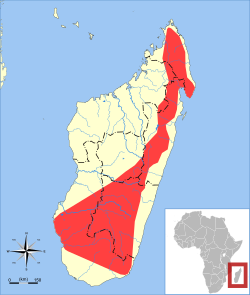| Major's long-fingered bat | |
|---|---|
| Scientific classification | |
| Kingdom: | Animalia |
| Phylum: | Chordata |
| Class: | Mammalia |
| Order: | Chiroptera |
| Family: | Miniopteridae |
| Genus: | Miniopterus |
| Species: | M. majori |
| Binomial name | |
| Miniopterus majori Thomas, 1906 | |
 | |
| Major's long-fingered bat range | |
Major's long-fingered bat (Miniopterus majori) is a species of vesper bat in the family Miniopteridae. It is found only in Madagascar. It is similar to M. schreibersi of continental Africa, differing by having a shorter forearm, slightly longer digits and a narrow box-shaped skull. The pelage is often a greyish-brown colour, and the tragus is kidney-shaped and is a prominent feature. It is an insectivore and is viewed as a possible contributor to pest removal in Madagascar. [2] The species was named in honour of Swiss zoologist C. I. Forsyth Major.
